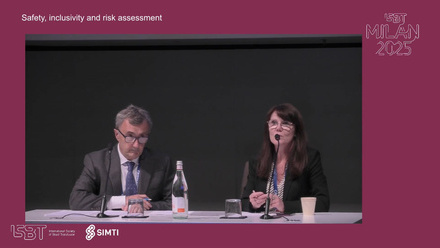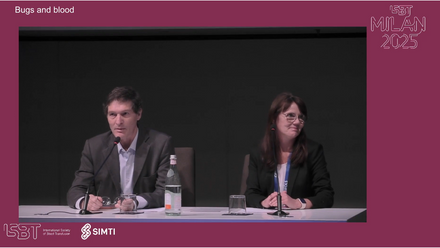The Epidemiology goes viral session included the following presentations:
1. Laura Tonnetti: The Impact of Babesia Testing on Transfusion-transmitted Babesiosis
2. Wen-Jie Liu: Ten-year experience of mini-pool nucleic acid testing in blood donors in Taiwan
3. Brian Custer: Prevalence, Incidence, and Residual Risk of HIV, HBV, and HCV in the US Blood Supply 2015 – 2021, on Behalf of the US TTIMS Program
4. Eduard Grebe: HIV incidence in US first-time blood donors during 12-month and 3-month MSM deferral policy periods on behalf of the US TTIMS Program
5. Daniel Candotti: Ten years insight into HBV molecular epidemiology in infected blood donors in Dalian, Northeast China
MODERATORS: Dudi Levi, Dorte Holm
After the presentation, there was a questions and answers session, which is also included in the recording.
Abstract
Ten-years insight into the HBV molecular epidemiology in infected blood donors in Dalian, Northeast China
X Deng1, X Guo1, D Wang1, H Gao1, D Candotti2
1Dalian Blood Center, Dalian, China, 2Dept Virology, Henri Mondor Hospital, Paris-Est University, Inserm U955-IMRB-Team 18, Creteil, France
Background: Hepatitis B virus (HBV) remains a high priority for Chinese blood banks due to the high prevalence of infection. The nine HBV genotypes (A-I) identified differ in their geographic distributions, transmission, disease progression, and clinical outcomes. HBV genotypes B (HBVB) and C (HBVC) are the major genotypes endemic in Mainland China, with HBVB being prevalent in the southern part and HBVC in the northern part of the country. However, these figures are mainly from patients and data on blood donors are still scarce.
Aims: To study retrospectively HBV genotype distribution over the past decade in a subset of HBV-infected blood donors in the Dalian blood center, Liaoning province, Northeast China.
Methods: HBV-infected donors were randomly selected according to sample availability: donors tested HBsAg+ pre-donation (group 1), donors tested HBsAg+ post-donation (irrespective of HBV DNA status; group 2), and donors with confirmed HBsAg-/HBV DNA+ occult HBV infection (OBI; group 3). Pre-donation testing was performed using a HBsAg rapid test (95% LoD: 5 IU/mL). HBsAg and HBV DNA were tested post-donation using two different ELISAs (95% LoD: 0.2 IU/mL), and mini-pool or individual-donation multiplex nucleic acid test (95% LoD: 3-10 IU/mL). The whole HBV genome or PreS/S and PreCore/Core regions were sequenced and HBV genotypes were identified by sequence phylogeny.
Results: Between 2011 and 2022, 5,299 of 844,594 (0.63%) candidate donors tested HBsAg+ pre-donation. Of 942,874 collected donations, 584 (0.06%) tested HBsAg+/HBV DNA + or -, and 563 (0.06%) donations were confirmed HBsAg-/HBV DNA +. The pre-donation HBsAg+ rate decreased 3-fold over the years (1.05% in 2013 to 0.35% in 2022), whereas no significant change was observed for post-donation HBsAg+ and OBI rates. HBV genotypes were 26 (25%) HBVB, 73 (71%) HBVC, 2 (2%) HBVB/C, and 2 (2%) HBVD in group 1; 53 (55%) HBVB, 42 (44%) HBVC, and 1 (1%) HBVB/C in group 2; and 23 (15%) HBVB, 125 (83%) HBVC, and 3 (2%) HBVD in group 3. HBVB and HBVC rates were not significantly different between group 1 and group 3. HBVB rate was significantly higher in group 2 compared to the other groups. Median HBV DNA load was significantly higher (p < 0.0001) in group 1 (8.7E+03 IU/mL [5.0-1.9E+10]) than in group 2 (2.9E+02 IU/mL [5.0-8.3E+06]) and group 3 (5.0 IU/mL [5.0-2.6E+03]). Viral loads were not significantly different between genotypes in all groups. Overall, the median HBsAg level was higher in group 1 (168 IU/mL [0.05-2.6E+06]) than in group 2 (0.6 [0.05-1.2E+04]) (p < 0.0001). However, HBVB samples showed lower HBsAg level than HBVC samples in group 1 (54.6 IU/mL [0.05-3.2E+03] vs 9.1E+02 IU/mL [0.05-3.4E+05]; p = 0.0004), whereas the opposite was observed in group 2 (HBVB: 1.12 IU/mL [0.05-2.5E+01] and HBVC: 0.3 IU/mL [0.05-1.2E+04]; p = 0.002). HBV strains from group 2 showed higher S protein amino acid diversity (HBVB: 5.8% [1.8-12.0%] and HBVC: 2.7% [0.0-7.5%]) than strains of corresponding genotypes from group 1 (HBVB: 2.7% [0.4-3.5%] and HBVC: 1.8% [0.0-9.4%]) (p < 0.0001). Potential immune escape mutations in S may be responsible for failure of pre-donation rapid testing (i.e. G130N+T131N and D144E+G145R).
Summary/Conclusions: A continuous decline in the yield of HBsAg pre-donation screening of blood donors has been observed in Dalian over the last decade. HBVC was prevalent in HBV-infected blood donors in Northeast China, especially in OBI carriers. Pre-donation rapid testing was less efficient in detecting HBVB infections. This might be related to higher antigenic variation in HBVB strains and lower HBsAg production. These data may prompt debate about whether to adapt pre-donation testing in Dalian.






